This blog post is way overdue. We have been home for a while, but have neglected to write a final trip post. So here we go…..
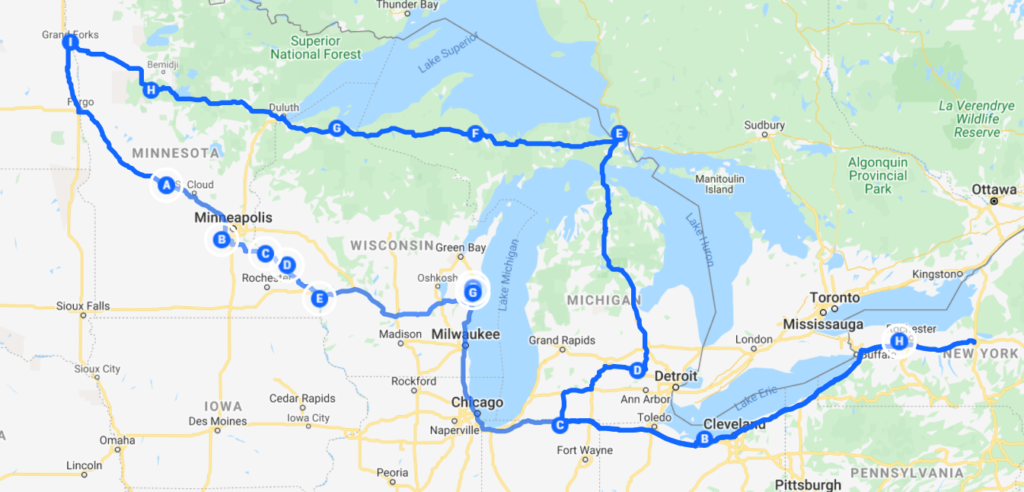
In our last post, we were at the sugar beet harvest back in early October. I’ll let Jim sum up the the end of the harvest, which included sugar beets and soy beans. Take it away Jim…
As mentioned in the previous post, the farmer I was helping was seriously short of truck drivers so they ask if I could stay on once the sugar beets were off the field. We originally had campground reservations for two weeks because that is the amount of time planned for the sugar beet harvest. Since we got done with the beets in six days, I agreed.
Side note; according to information we got, last year was the longest sugar beet harvest on record, this year was the shortest. So the harvest went quick for all the farmers, not just for our crew. But the harvest was light this year because of excessive early season rain drowning out big areas in the field and poor weather early on got the plants off to a slow start. 25 to 30 tons per acre is considered a good yield. The farm I helped only averaged 20 tons per acre.
So on to soybeans. I started hauling soybeans within hours after the beets were finished. They had lots of juggling to get everything switched over. So while some crews were bringing back all the beet harvest equipment, switching tractors, and doing numerous other tasks, a few of us started soybeans. We only had one combine in the morning, two combines by lunch, and three combines by the end of the day. Each combine had a 45 foot header, so three combines going down to the other end of the field and back removed a 270 feet width of soybeans. In other words on a one half mile long field, one trip down and back harvested over 16 acres of soybeans!
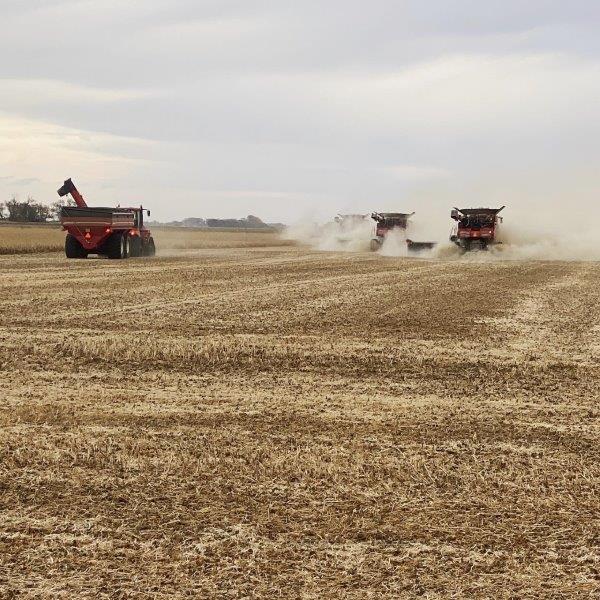
As you can see in the pictures they had a grain cart chasing the combines to receive the grain from them so the combines never had to stop. The full grain cart would then drive over to the trucks to fill them. Since the grain cart can hold up to 1500 bushels, and each truck only held between 850 and 900 bushels, the grain cart could load out a full truck load every time. After the first day we had the three combines running steadily and we had three truck drivers. But since we were hauling the soybeans to multiple grain elevator locations quite far away, the trucks could not keep up. So when a spare person was available, that person would bring extra semis to the field and park them to be loaded when we fell behind. At the end of the day we (the crew of three truck drivers) would leave the trucks we had just emptied in the field and take the extra trucks, which were now full, back to the shop. We had to take them to the shop because the grain elevators had closed for the day and we combined until dark every day (at which point the soybean plants got too moist to continue) . Since the combines had to wait for the dew to dry in the morning, they couldn’t start too early. So the truck drivers (i.e. me) would roll in at 7 a.m. and take the loaded trucks from the night before and head off to empty them at the grain elevator before the combine crews got started. So we were able to keep up. Barely.
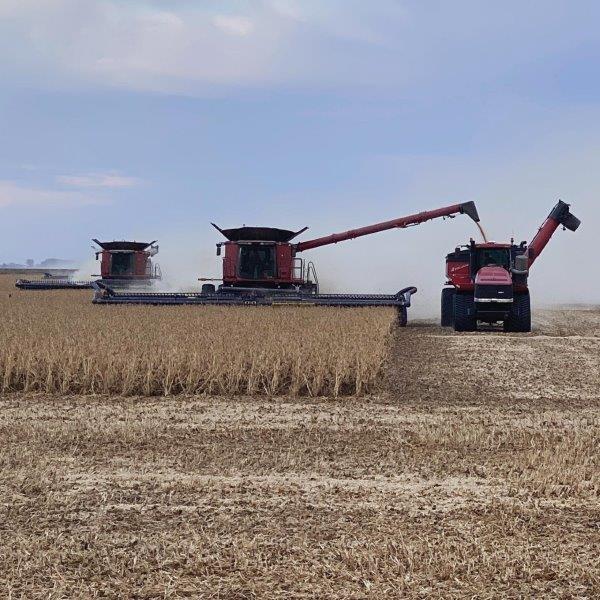
While we working on the soybeans, they got another crew working on the wheat. Both crews were using radios on the same radio frequency, which worked OK until the day the wheat crew ran a skunk through one of the wheat combines. This set off so many of the combine’s crop sensors and alarms they had to reset the entire machine. At this point the wheat crew started making so many comments and jokes about skunks, that our soybean crew got fed up and switched to our own frequency. So I never did hear the conclusion of the skunk story.
We harvested dozens of fields scattered around the North Dakota country side. It was not unusual to leave one field with a load and return empty to a different field. Sometimes finding the field turned into a treasure hunt. They use local names for the roads. And the local names are not on any map. Names like Thompson Road and Hatton Road. Most of the roads are actually numbered with street numbers or County Highway numbers. But none of the locals know any of these, they all use the local names. As an example, for one field I was given this complicated set of instructions involving power lines, trees, farm driveways, etc. As I’m driving down the road to the field I notice that there are street signs at each corner. And they are numbered sequentially. So the road I eventually turned on was 162th Ave NE. Did any of them know that? No! That would be too easy.
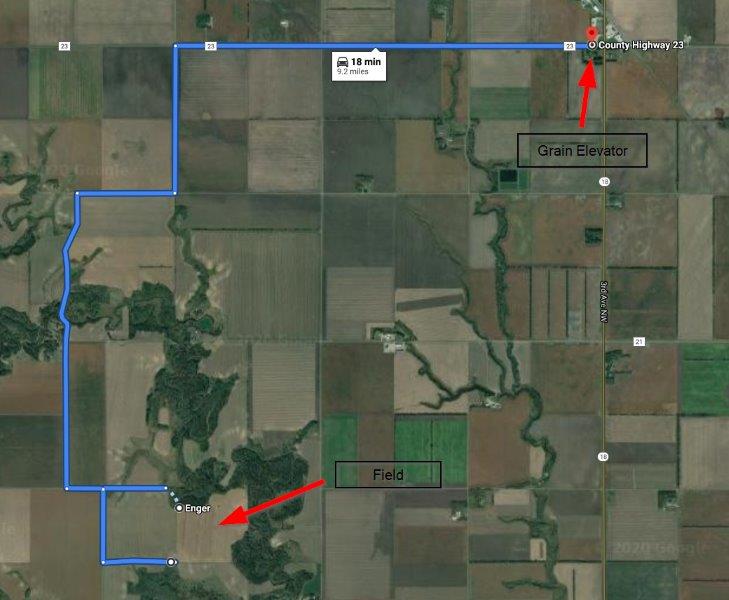
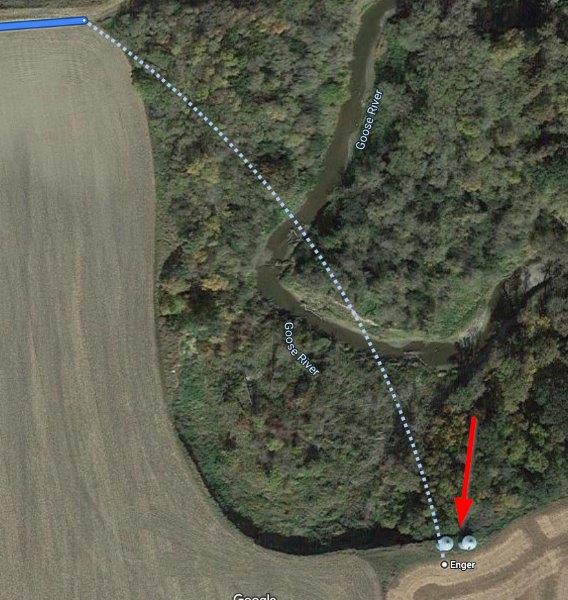
In addition the driveways to the fields, which they call approaches, are extremely narrow. So to turn in, you have to drive with one side of the semi-truck in the opposite ditch and turn as short as possible to keep the rear wheels of the semi trailer from dropping of the edge of the approach. And some fields don’t even have approaches. On one field, they had a pickup come out and lead me in because we went “around the river and through the woods” driving through some other farmer’s fields so far back in that you couldn’t even see the field from the road. At another field, they told me to turn in at a farm driveway then immediately turn right. As I’m turning in I look to the right, it’s not an approach, it’s a ditch. I should mention that most of the ditches while quite deep have shallow side slopes and wide flat bottoms. So I look, sure enough, there are tire tracks through the ditch. So in I go into the ditch and follow the tracks to the field. But as I was driving into the field on the bottom of the ditch, the though crossed my mind, what would they do if it was wet? Would they put pontoons on the trucks?
While I was getting loaded, three different people warned me that they did not have a tractor to pull me when I leave, so I had to get going as fast as I could in the ditch to make sure I got back up on the road and didn’t get stuck in the ditch. Of course, the road I’m going up onto is one of the few paved roads in the area which meant that it actually had traffic (we were mostly on gravel and in some cases seasonal roads more appropriately called lanes) . So I was being told to come blasting out of the ditch onto one of the few roads that is big enough to actually have traffic. Luckily I was able to find an opening to drive into.
The weather continued to cooperate and we only had minor breakdowns that we could fix on the fly. So by ramping up on Monday morning and running at full speed the rest of the week, we harvested 3000 acres of soybeans by Saturday night. The wheat crew was able to finish their harvest about one hour after us. At the start of the harvest, the bosses were very tense and nervous due to two bad harvest years in a row; not having been able to start wheat or soybeans before the sugar beet harvest, and wondering what would happen this year. But after 12 days, in which we harvested all the sugar beets, soybeans, and wheat, they were so relaxed and happy that they gave all the crews the next day (Sunday) off. The field boss said he could not remember the last time they had all taken a day off during harvest.
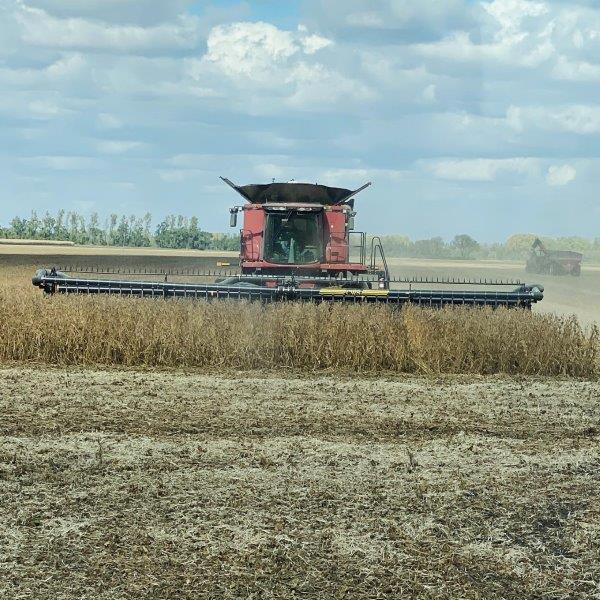
In 12 days I worked 143 hours, or almost 12 hours a day. Sugar beet days were a bit longer and soybean days a bit shorter. Or in other words I made almost enough money in 12 days to pay our RV diesel fuel bill for the entire year. So I guess that makes it worthwhile.
Now back to Corinne….
After our time at the harvest, we headed eastward to see family and friends. We made quick stop in the Minneapolis area and had an outside lunch with Jim’s sister Elle and her husband Jerry. It was good to catch-up.
Next on the agenda were Jim’s cousin Dennis and his wife Jeanne who live in La Crescent, Minnesota, a town on the Mississippi River. Geography refresher – The Mississippi River serves as the border between Minnesota and Wisconsin. To get to La Crescent, we drove south along the west bank of the Mississippi. This was a new route for me. It was a beautiful, sunny Fall day. The scenery exceeded all expectations.
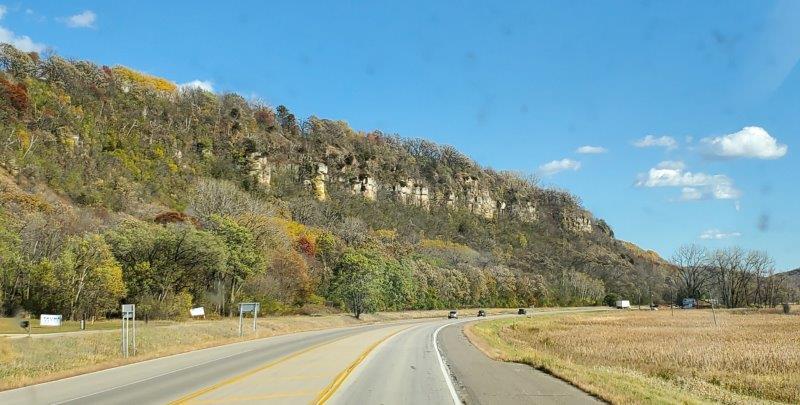
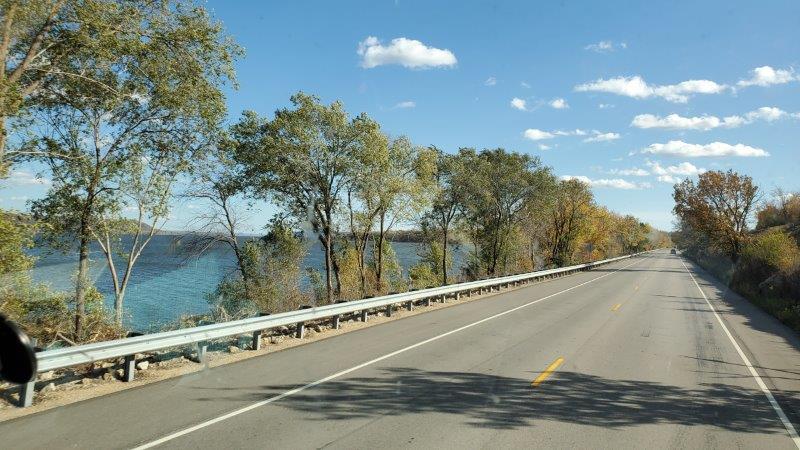
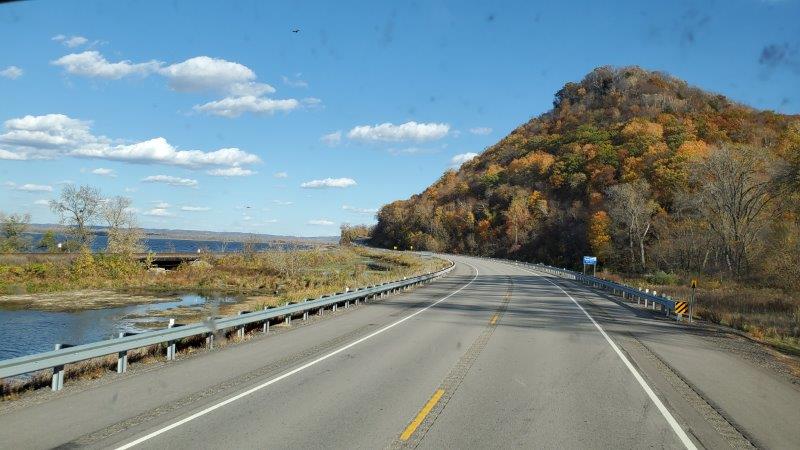
While driving, Jim dredged up from the recesses of his brain that we were in the “Driftless Area.” Huh? Queue up Wikipedia.
Retreating glaciers leave behind material called drift composed of silt, clay, sand, gravel, and boulders. The Driftless Area is a region in southwestern Wisconsin, southeastern Minnesota, northeastern Iowa, and the extreme northwestern corner of Illinois, of the American Midwest. The region escaped the flattening effects of glaciation during the last ice age and is consequently characterized by steep, forested ridges, deeply carved river valleys, and karst geology characterized by spring-fed waterfalls and cold-water trout streams.
https://en.wikipedia.org/wiki/Driftless_Area
Who knew? Apparently Jim did. We were driving through the Driftless Area, land that the ice age didn’t touch. How interesting!
We arrived at our campground and arranged to visit Dennis and Jeanne the next day. It was a great visit until….
I stood up and my left knee started to swell. The knee had been problematic the whole trip, with the swelling coming and going. This time the swelling was so bad, we had to borrow Dennis’s crutches to get me to the car and back to the RV (thanks Dennis!).
With ice packs, ibuprofen and a cane, we pushed on to Jim’s hometown of Cleveland, Wisconsin. We had a wonderful visit with Allen (best man at our wedding) and his wife Bonnie. We also saw Jim’s brother Tom and wife Cheryl. Alas, the knee was not cooperating. With two more painful swelling incidents in 24 hours, we decided to cut the trip short and drove back to New York State in one day.
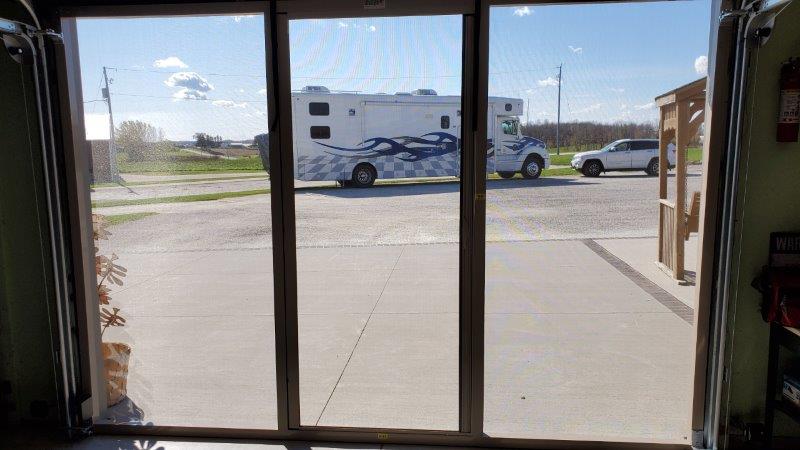
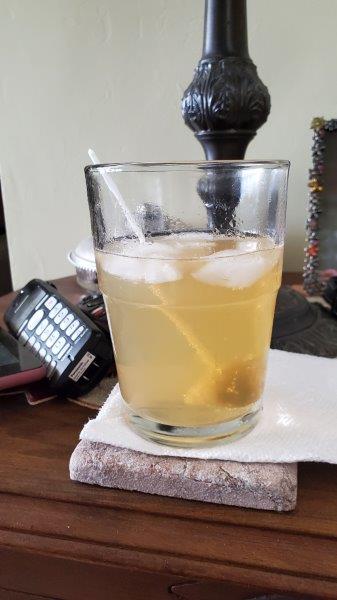
Since we got home, I’ve seen the doctor and was told I have BAD arthritis and will need a knee replacement. NO!!!! We just went through two knee replacements last summer with Jim. But what else could one expect, this is 2020 after all.
Jim’s knees are doing great, by the way!
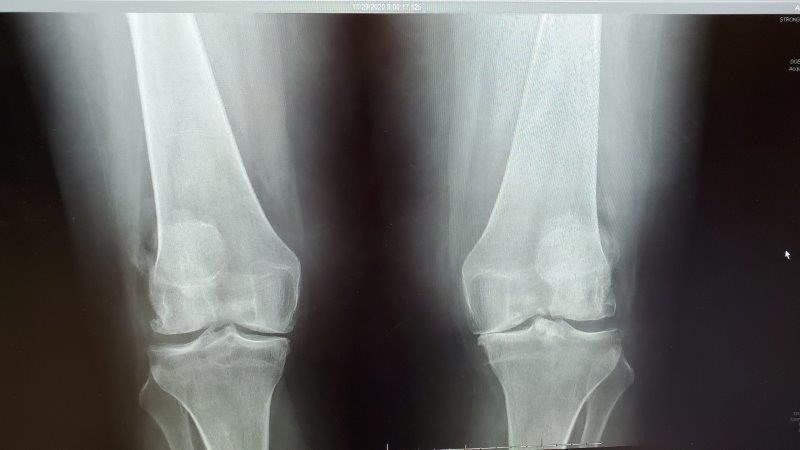
For now, I have had a cortisone shot to bring the swelling down and am doing physical therapy to strengthen the muscles. We are working on getting my range of motion back. But I am still walking with a limp and the knee is still swollen, fortunately not painfully so.
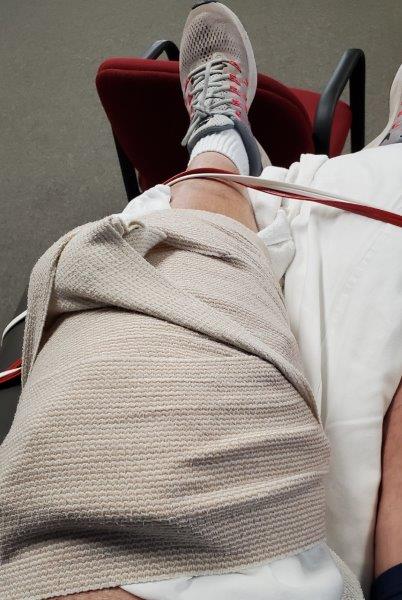
That’s where stand. We are back home. COVID is raging. States are starting to lock down again. I need a new knee. Who knows what will happen come 2021? Will we be able to head to the Southwest? Will my knee want to travel? Can I have surgery ASAP?
Life is nothing but a series of questions right now. With the help of our friend Dave, Jim got the RV winterized and back in storage in Ohio. We are staying home for the next few months, wondering like everyone else, what is next?
Stay safe everyone. We will ALL be able to travel again someday.
As always, thanks for the blog and info. I think that at this point, Jim is capable of driving any kind of vehicle anywhere!! Next time you will have to get a picture of Jim driving one of those big machines.
So good to hear you are on the road again! I loved the beets, beans, and wheat details and also appreciated the knee details.